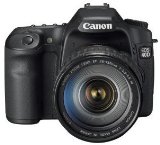Camera Models – why I love Canon
Alright, so now that you understand it doesn”t really matter what camera you buy, I”m going to suggest a camera to buy ![]() If you don”t like my suggestion though, I certainly won”t hold it against you (in fact I”ll even suggest some alternatives!) . . . and you will still be able to take great pictures.
If you don”t like my suggestion though, I certainly won”t hold it against you (in fact I”ll even suggest some alternatives!) . . . and you will still be able to take great pictures.
To recap the previous articles, a) buy a digital camera, b) buy an SLR, c) don”t pay much attention to megapixels. The two most important considerations for the camera are the quality of the optics, and the quality of the CCD (image sensor) . . . and there is no standard measure or marketing term for these factors.
For optics quality, the best cameras are Canons and Nikons – they”ve been the best for years, and continue to outperform other cameras. Between the two brands, optic quality goes back and forth depending on who”s released the latest upgrade. Canon had a better platform for awhile (they”ve been placing the focus motor in the lens rather than the camera body for years, which speeds up the performance among other things), but Nikon recently switched over to a similar platform which is holding its own.
For image sensor quality, Canon and Nikon have also historically lead the pack. Again, quality between the two of them tends to go back and forth model to model. Recently, several new players, most notably Sony, have entered the arena of high quality image sensors. In fact Sony”s CCD is good enough that they teamed up with Carl Zeiss (a microscope and precision optics manufacturer) to try and bring their optics into a competitive range with Canon and Nikon. Sony has been successful in developing a line of SLRs that have Canon and Nikon nervous, but in my opinion they are still playing outside their core competancy and have some work ahead of them before I would recommend one of their cameras.
Between Canon and Nikon as I mentioned, it”s sort of a toss-up on which brand you buy. So why do I buy Canon? Because they have more experience with in-lens motors, because I used to shoot with a 35mm Canon Rebel and got used to the controls, and because all my old lenses are compatable with my new cameras! That”s it.
Ok, Canon still has a wide range of SLRs though. So which to buy? I would honestly go with the Rebel XSi to the left. “But that”s the cheap one!” you might say. Right. It”s probably all you need. Even if you”re a budding professional, it”s probably all you need. I shot with the precursor of this model for years, and I upgraded for 1 reason only – I need a faster shooting rate (frames/second) to capture multiple exposures of moving subjects and a larger burst shot capacity (number of photos that can be taken before the memory card write speed slows down the shooting rate). If you don”t need to shoot lots of exposures quickly, there is almost no reason to buy anything more expensive than the Rebel XSi.
If, on the other hand, you do need high speed shooting capability (for example to minimize blur for HDR photos, or if you are heavy into sports photography), then the Canon 40D is your best value. I know, it”s not Canon”s most expensive model either. I”m trying to save you some money – the new 50D doesn”t add much other than some more megapixels, and a moderately increased useful range for low light photography. That”s it. And the 5D (the next step up) almost triples the price.
By the way, the product links above include both the camera body and a lens. Both cameras are fully compatible with the entire EOS line of lenses, so if you don”t need a lens here is the Rebel Body Only or the 40D Body Only. The 40D actually has a couple options for the lens that comes with it if you buy as a kit, but the 28-135mm included in the above link is probably your best bet quality-wise.
That”s all you should need! Time to get shooting ![]() Ok, if you want to browse around Canon”s other offerings by all means go ahead. Or if you want to try your hand with a Nikon, look for cameras with similar price points and features as one of the Canons I mention above. You really can”t go wrong.
Ok, if you want to browse around Canon”s other offerings by all means go ahead. Or if you want to try your hand with a Nikon, look for cameras with similar price points and features as one of the Canons I mention above. You really can”t go wrong.





Leave a Reply